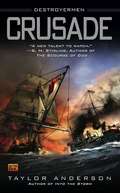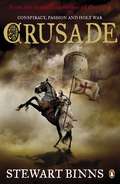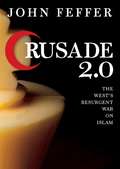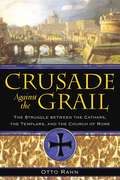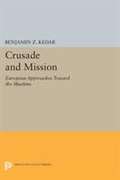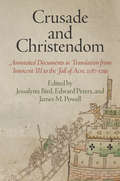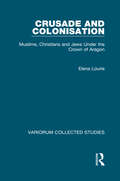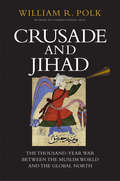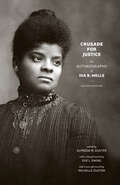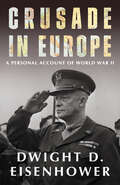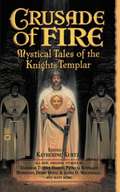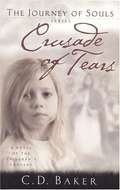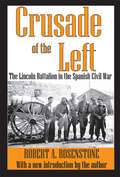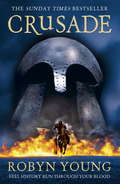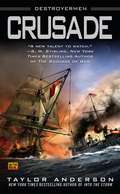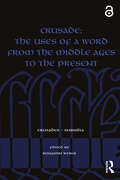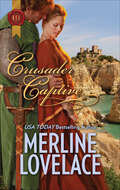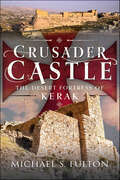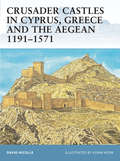- Table View
- List View
Crusade (Destroyermen, Book #2)
by Taylor AndersonNEW WORLD. OLD ENEMIES. After being swept from the World War II Pacific into an alternate world, Lieutenant Commander Matthew Reddy and the crew of the USS Walker have allied with the peaceful Lemurians in their struggle against the warlike reptilian Grik. But they are sorely outnumbered, and even the power of Walker cannot turn the tide of battle. Then Reddy finds Mahan, the other destroyer that passed through the rift. Together the ships will teach the Lemurians to stand and fight. Or so they think. For there is another vessel at large: the Amagi, the massive Japanese battleship that Walker was fleeing back in the Pacific. The Amagi also came through the rift ....And the Amagi is in the hands of their enemies.
Crusade (The Making of England Quartet #2)
by Stewart Binns1072 - England is firmly under the heel of its new Norman rulers. The few survivors of the English resistance look to Edgar the Atheling, the rightful heir to the English throne, to overthrow William the Conqueror. Years of intrigue and vicious civil war follow: brother against brother, family against family, friend against friend.In the face of chaos and death, Edgar and his allies form a secret brotherhood, pledging to fight for justice and freedom wherever they are denied. But soon they are called to fight for an even greater cause: the plight of the Holy Land. Embarking on the epic First Crusade to recapture Jerusalem, together they will participate in some of the cruellest battles the world has ever known, the savage Siege of Antioch and the brutal Fall of Jerusalem, and together they will fight to the death.
Crusade 2.0
by John FefferIn his official response to the attacks of September 11, George W. Bush invoked the Crusades, tapping into a centuries-long history of fear and aggression. The West's longstanding perception of Islam as a threat has taken on new and more complex implications in the twenty-first century, as years of migration and resulting demographic shifts have brought the "enemy" within Western borders. Virulent opposition to the planned construction of an Islamic center near the 9/11 attack site in New York City reveals much about the intensity of public sentiments simmering just below the surface. As the United States and countries across Europe struggle with a resurgence of unexamined fear and antagonism, often directed against their own citizens, the imperative for better understanding could not be greater.Crusade 2.0 examines the resurgence of anti-Islamic sentiment in the West and its global implications. John Feffer discusses the influence of three "unfinished wars"-the Crusades, the Cold War, and the current "war on terror." He presents a timely, concise and provocative look at current events in the context of historical trends and goes beyond a "clash of civilizations" critique to offer concrete ways to defuse the ticking bomb of Islamophobia.John Feffer is co-director of Foreign Policy in Focus at the Institute for Policy Studies in Washington, DC. He is the author of several books, including North Korea, South Korea. His essays have been published in The New York Times, The Boston Globe, and elsewhere; he has been interviewed by CNN, MSNBC, Al Jazeera, Democracy Now! and other international news media.
Crusade Against the Grail: The Struggle between the Cathars, the Templars, and the Church of Rome
by Otto RahnThe first English translation of the book that reveals the Cathar stronghold at Montségur to be the repository of the Holy Grail • Presents the history of the Papal persecution of the Cathars that lies hidden in the medieval epic Parzival and in the poetry of the troubadours • Provides new insights into the life and death of this gifted and controversial author Crusade Against the Grail is the daring book that popularized the legend of the Cathars and the Holy Grail. The first edition appeared in Germany in 1933 and drew upon Rahn’s account of his explorations of the Pyrenean caves where the heretical Cathar sect sought refuge during the 13th century. Over the years the book has been translated into many languages and exerted a large influence on such authors as Trevor Ravenscroft and Jean-Michel Angebert, but it has never appeared in English until now. Much as German archaeologist Heinrich Schliemann used Homer’s Iliad to locate ancient Troy, Rahn believed that Wolfram von Eschenbach’s medieval epic Parzival held the keys to the mysteries of the Cathars and the secret location of the Holy Grail. Rahn saw Parzival not as a work of fiction, but as a historical account of the Cathars and the Knights Templar and their guardianship of the Grail, a “stone from the stars.” The Crusade that the Vatican led against the Cathars became a war pitting Roma (Rome) against Amor (love), in which the Church triumphed with flame and sword over the pure faith of the Cathars.
Crusade And Mission: European Approaches Toward The Muslims
by Benjamin Z. KedarThis wide-ranging study of medieval Europe's response to the challenge of Islam examines the relationship between ideas of crusade and mission, between European projects for military conquest and those for the conversion of Muslims to Christianity. Covering the years from the emergence of Islam to the fourteenth century, Benjamin Z. Kedar discusses not only the crusades and the Crusading Kingdom of Jerusalem but also the confrontation of Catholics and Muslims in Sicily and Spain. Originally published in 1984. The Princeton Legacy Library uses the latest print-on-demand technology to again make available previously out-of-print books from the distinguished backlist of Princeton University Press. These editions preserve the original texts of these important books while presenting them in durable paperback and hardcover editions. The goal of the Princeton Legacy Library is to vastly increase access to the rich scholarly heritage found in the thousands of books published by Princeton University Press since its founding in 1905.
Crusade and Christendom
by Edward Peters James M. Powell Jessalynn BirdIn 1213, Pope Innocent III issued his letter Vineam Domini, thundering against the enemies of Christendom--the "beasts of many kinds that are attempting to destroy the vineyard of the Lord of Sabaoth"--and announcing a General Council of the Latin Church as redress. The Fourth Lateran Council, which convened in 1215, was unprecedented in its scope and impact, and it called for the Fifth Crusade as what its participants hoped would be the final defense of Christendom. For the first time, a collection of extensively annotated and translated documents illustrates the transformation of the crusade movement.Crusade and Christendom explores the way in which the crusade was used to define and extend the intellectual, religious, and political boundaries of Latin Christendom. It also illustrates how the very concept of the crusade was shaped by the urge to define and reform communities of practice and belief within Latin Christendom and by Latin Christendom's relationship with other communities, including dissenting political powers and heretical groups, the Moors in Spain, the Mongols, and eastern Christians. The relationship of the crusade to reform and missionary movements is also explored, as is its impact on individual lives and devotion. The selection of documents and bibliography incorporates and brings to life recent developments in crusade scholarship concerning military logistics and travel in the medieval period, popular and elite participation, the role of women, liturgy and preaching, and the impact of the crusade on western society and its relationship with other cultures and religions.Intended for the undergraduate yet also invaluable for teachers and scholars, this book illustrates how the crusades became crucial for defining and promoting the very concept and boundaries of Latin Christendom. It provides translations of and commentaries on key original sources and up-to-date bibliographic materials.
Crusade and Colonisation: Muslims, Christians and Jews Under the Crown of Aragon (Variorum Collected Studies)
by Elena LourieThe history of the Reconquista - the Christian reconquest of Spain from the Arabs - has proved an increasingly stimulating field of historical research. On the one hand, the struggle forced Spanish society into a mould which then shaped the course of its expansion into the Americas, on the other it gave rise to a unique process of accommodation and acculturation. Dr Lourie here concentrates on the realms of the Crown of Aragon in the 12th-14th centuries. The first articles deal with the evolution of the crusading spirit, with geopolitics, notably the rivalry between Aragon and Castille, and with the progress of Christian colonisation. The next section examines the conflicting demands of ideology, demography and colonisation, and includes one major new study on Christian ambivalence towards the Mudejars, the conquered Muslim population. Dr Lourie seeks to throw this attitude into sharper focus by comparing the Muslim situation with that of the Jews, and it is to the latter and their relations with Christians that her last five articles are devoted.
Crusade and Conversion on the Baltic Frontier 1150–1500
by Alan V. MurrayThis volume represents a major contribution to the history of the Northern Crusades and the Christianization of the Baltic lands in the Middle Ages, from the beginnings of the Catholic mission to the time of the Reformation. The subjects treated range from discussions of the ideology and practice of crusade and conversion, through studies of the motivation of the crusading countries (Denmark, Sweden and Germany) and the effects of the crusades on the countries of the eastern Baltic coast (Finland, Estonia, Livonia, Prussia and Lithuania), to analyses of the literature and historiography of the crusade. It brings together essays from both established and younger scholars from the western tradition with those from the modern Baltic countries and Russia, and presents in English some of the fruits of the first decade of historical scholarship and dialogue after the collapse of the Iron Curtain. The depth of treatment, diversity of approaches, and accompanying bibliography of publications make this collection a major resource for the teaching of the Baltic Crusades.
Crusade and Jihad: The Thousand-Year War Between the Muslim World and the Global North
by William R. PolkCrusade and Jihad is the first book to encompass, in one volume, the entire history of the catastrophic encounter between the Global North—China, Russia, Europe, Britain, and America—and Muslim societies from Central Asia to West Africa. William R. Polk draws on more than half a century of experience as a historian, policy planner, diplomat, peace negotiator, and businessman to explain the deep hostilities between the Muslim world and the Global North and show how they grew over the centuries. Polk shows how Islam arose and spread across North Africa into Europe, climaxed in the vibrant and sophisticated caliphate of al-Andalus in medieval Spain, and was the bright light in a European Dark Age. Simultaneously, Islam spread from the Middle East into Africa, India, and Southeast Asia. But following the Mongol invasions, Islamic civilization entered a decline while Europe began its overseas expansion. Portuguese buccaneers dominated the Indian Ocean; the Dutch and the English established powerful corporations that turned India and Indonesia into colonies; Russian armies pushed down the Volga into Central Asia, destroying its city-states; and the Chinese Qing dynasty slaughtered an entire Central Asian people. Britain crushed local industry and drained off wealth throughout its vast colonies. Defeated at every turn, Muslims tried adopting Western dress, organizing Westernstyle armies, and embracing Western ideas. None of these efforts stopped the conquests. For Europe and Russia, the nineteenth century was an age of colonial expansion, but for the Muslim world it was an age of brutal and humiliating defeat. Millions were driven from their homes, starved, or killed, and their culture and religion came under a century-long assault. In the twentieth century, brutalized and and disorganized native societies, even after winning independence, fell victim to “post-imperial malaise,” typified by native tyrannies, corruption, and massive poverty. The result was a furious blowback. A sobering, scrupulous, and frank account of imperialism, colonialism, insurgency, and terrorism, Crusade and Jihad is history for anyone who wishes to understand the civilizational conflicts of today’s world.
Crusade for Democracy, Revised Edition: Progressive Education at the Crossroads
by Daniel TannerAttacks on public schools and efforts to impose nationalizing "reforms" are no less threatening today than they were during the era of progressive education under the conditions that gave rise to the John Dewey Society. Crusade for Democracy, Second Edition, tells the fascinating story of the Progressive Education movement of the 1930s and 1940s, whose core is the founding and early activities of the John Dewey Society for the Study of Education and Culture. In a compelling narrative, Daniel Tanner details, through close examination of the scholarly literature and heretofore unexamined archival materials, the colorful personalities and powerful philosophies of this group of educators who worked from the conviction that the struggle and growth of American democracy could not be conducted apart from the public schools. The issues to which the Society directed its attention are, he argues, perennial ones—the appropriate relationship between school and society, the purpose of education in a democracy, social inequality, textbook censorship, academic freedom, and so on. In this new edition, Tanner points to such recent phenomena as charter schools, testing mandates, and narrowed "core standards" curricula as raising the question of whether the John Dewey Society is losing its way, becoming just another philosophical society, or whether it will reclaim its legacy by advancing the democratic prospect for school and society.
Crusade for Justice: The Autobiography of Ida B. Wells (Negro American Biographies and Autobiographies)
by Ida B. Wells“She fought a lonely and almost single-handed fight, with the single-mindedness of a crusader, long before men or women of any race entered the arena; and the measure of success she achieved goes far beyond the credit she has been given in the history of the country.”—Alfreda M. Duster <P><P> Ida B. Wells is an American icon of truth telling. Born to slaves, she was a pioneer of investigative journalism, a crusader against lynching, and a tireless advocate for suffrage, both for women and for African Americans. She co-founded the NAACP, started the Alpha Suffrage Club in Chicago, and was a leader in the early civil rights movement, working alongside W. E. B. Du Bois, Madam C. J. Walker, Mary Church Terrell, Frederick Douglass, and Susan B. Anthony. <P><P> This engaging memoir, originally published 1970, relates Wells’s private life as a mother as well as her public activities as a teacher, lecturer, and journalist in her fight for equality and justice. This updated edition includes a new foreword by Eve L. Ewing, new images, and a new afterword by Ida B. Wells’s great-granddaughter, Michelle Duster.
Crusade in Europe
by Dwight D. EisenhowerFive-star General Dwight D. Eisenhower was arguably the single most important military figure of World War II. For many historians, his memoirs of this eventful period of U.S. history have become the single most important record of the war. Crusade in Europe tells the complete story of the war as Eisenhower planned and lived it. Through his eyes, the enormous scope and drama of the war—strategy, battles, moments of fateful decision—become fully illuminated in all their fateful glory. Yet this is also a warm and richly human account. Ike recalls the long months of waiting, planning, and working toward victory in Europe. His personal record of the tense first hours after he had issued the order to attack—and there was no turning back—leaves no doubt of Eisenhower's travail and reveals this great man in ways that no biographer has ever surpassed.
Crusade of Eagles (Eagles #12)
by William W. Johnstone J.A. JohnstoneThe MacCallister siblings unite in a thundering frontier adventure from the greatest Western writer of the 21st century. They Fought for Fame and Fortune The MacCallister clan was raised on a harsh, unforgiving frontier, where courage and blood bonds mattered the most. While Falcon MacCallister followed his father&’s mountain man legacy, his brother and sister made their fame and fortune on another kind of battleground. Now they&’re planning a family reunion. Andrew and Rosanna MacCallister are headed to Colorado to visit their kin—until they step into the crosshairs of a murderer&’s plan . . .Now They Will Fight for Their Lives . . . Luke Broskie didn&’t know that the two actors from back East had a brother named Falcon. Or how fiercely that brother would fight for his kin after Broskie&’s men kidnapped them for ransom. Soon Broskie must call in his own little army to crush his new worst enemy. But Falcon MacCallister is on a crusade—and his war won&’t be over until the last six-shooter spits . . . Praise for the Eagles series &“[A] rousing, two-fisted saga of the growing American frontier.&”—Publishers Weekly &“Solid, page-turning entertainment featuring a larger-than-life, old-fashioned hero in MacCallister.&”—Booklist
Crusade of Fire: Mystical Tales of the Knights Templar
by Katherine KurtzThe Knights Templar were the fabled order of mystic warrior-monks supposedly disbanded more than seven centuries ago by the pope. Legends persist of their presence, and this collection of stories muse on the Knights' arrival at history's turning points to guide destiny in Good's eternal war against Evil.
Crusade of Tears: A Novel of the Children's Crusade (The Journey of Souls #1)
by C. D. BakerCrusade of Tears will transport you back to the 13th Century--the dark era of the Children's Crusade, when 50,000 French and German children were falsely inspired to reclaim the Holy City. Author C.D. Baker masterfully paints an unforgettable portrait that blends thoroughly researched historical accounts with a compellingly personal plot that focuses on a small band of pilgrims, led by stout-hearted Wil, his eager brother Karl, and their gentle sister Maria. This realistic story of faith in the midst of extraordinary hardships will speak to you from across the centuries and far into the future.
Crusade of the Left: The Lincoln Battalion in the Spanish Civil War
by Robert RosenstoneBetween 1936 and 1938, some 3,000 young Americans sailed to France and crossed the Pyrenees to take part in the brutal civil war raging in Spain. Virtually all joined the International Brigades, formed under the auspices of the Soviet-led Comintern and largely directed by Communists. Yet a large number were not Communists; their activism was inspired by domestic and international crises of the 1930s, and colored by idealism.The men who went to Spain came out of a radical subculture that emerged from the Depression and the New Deal. Th is radicalism was a native plant, but it was nourished from abroad. In the thirties the menace of fascism seemed to be spreading like cancer across Europe, giving an international aspect to many domestic problems in the United States. To intellectuals, students, unionists, liberals, and leftists, the threat of fascism was so real that many came to believe that if it was not stopped in Spain, eventually they would have to take up arms against fascism at home.To understand the Americans who fought in the Spanish Civil War it is necessary to bury some of the shibboleths of cold war years. Dissidence in the United States occurs in response to perceptions of reality on this side of the Atlantic, not because of the wishes of men in the Soviet Union. Th e members of the Lincoln Battalion were genuine products of America, and their story is properly a page in American military and political history. From them, one can learn much about the world of the 1930s and perhaps even something about the potential of modern man for thought and action in time of crisis.
Crusade: Brethren Trilogy Book 2 (Brethren Trilogy)
by Robyn YoungRobyn Young is a compelling voice in historical fiction, writing in the tradition of Bernard Cornwell, Conn Iggulden and Manda Scott. This is the epic second novel in the million-selling Brethren trilogy.It is 1274 and in the fortified city of Acre, the last major stronghold of the Crusaders in Palestine, an epic conflict is beginning. Will Campbell is a Templar Knight, trained for war, but as a member of the mysterious group known as the Brethren, he is also a man of peace. After years of bloodshed the Brethren have helped create a truce between the Christians and Muslims. But there are those on both side for whom peace is not an option. As war looms, Will is torn between his oath as a Templar, his secret role in the Brethren and his duty to Elwen, the woman he loves but is forbidden to marry.
Crusade: Chronicles of an Unjust War
by James CarrollAnalyzes the war against Iraq within our history of war-making.
Crusade: Destroyermen, Book II
by Taylor AndersonThe ?gripping and riveting?( S.M. Stirling, author of The Scourge of God) Destroyermen saga continues.Lieutenant Commander Matthew Reddy, along with the men and women of the USS Walker, have chosen sides in a war not of their making. Swept from the World War II Pacific into an alternate world, they have allied with the Lemurians?a mammalian race threatened by the warlike reptilian Grik. The Lemurians are vastly outnumbered and ignorant of warfare, and even the guns and technology of Walker cannot turn the tide of battle. Luckily they are not alone?Reddy finally finds Mahan, the other destroyer that passed through the rift. Together, the two American ships will teach the Lemurians to make a stand. Or so they think. For the massive Japanese battleship Amagi, the very ship that Walker was fleeing from when the rift took them, has followed them through. And now the Amagi is in the hands of the Grik.
Crusade: The Uses of a Word from the Middle Ages to the Present (Crusades - Subsidia)
by Benjamin WeberThe word ‘crusade’ covers today a wide variety of meanings in most European languages. The link between these uses and the historical phenomenon labelled as ‘crusade’ by historians is often very narrow and particularly changing. Understanding the real meaning of the word ‘crusade’, its connotations and implications, and thus the conscious or unconscious intentions of its uses requires a precise knowledge of the historical evolutions of the word, from its first appearance in the 13th century until nowadays.This book offers the first comprehensive view of the historical construction of the meaning of the word ‘crusade’ through comparative perspectives from the Middle Ages to the 21st century. Its 11 articles, introduction and conclusion examine different uses of the word, in a single language or within a specific context, and analyse each of them as a different conceptualisation of the crusading phenomenon. The book explains the progressive widening of the meaning of the term, from a military expedition to Jerusalem to the most metaphorical uses. It demonstrates the differences between the connotations of the word in various languages and cultures and, thus, the variety of its possible uses. It insists on the reluctance and reticence that ‘crusade’ has always provoked since the Middle Ages, precisely because the conceptualisation it implied was not shared by all.The book will be of interest not only for crusade scholars and for diachronic linguists but also for anyone interested in understanding better modern discourses and references to the ‘crusade’ by politicians, activists, and journalists, through a precise inquiry on the historical developments of the word and the variety of its meanings.
Crusader
by Nigel TranterAlexander III of Scotland was just seven years old when he inherited thethrone. South of the border, England's King Henry III saw this as hischance to assert his paramountcy over the kingdom. At the age of ten,the boy was married to Henry's daughter.But through the hazards of power politics and dynastic marriage - oneman stood by the young monarch. Whether it was shooting wild geese,helping him escape from the prison-like confines of Edinburgh Castle orteaching him to stand up both to his ever-threatening Englishfather-in-law and the unending feuds of his own countrymen, David deLindsay of Luffness in East Lothian was Alexander's one true andconstant friend.But David's only wish was to be a crusader, a wish he was finally tofulfil when the boy became a man.The turbulent 13th century story of the child king Alexander III ofScotland and David de Lindsay of Luffness, his one true supporter, in anage of crusades and wars.
Crusader
by Nigel TranterAlexander III of Scotland was just seven years old when he inherited thethrone. South of the border, England's King Henry III saw this as hischance to assert his paramountcy over the kingdom. At the age of ten,the boy was married to Henry's daughter.But through the hazards of power politics and dynastic marriage - oneman stood by the young monarch. Whether it was shooting wild geese,helping him escape from the prison-like confines of Edinburgh Castle orteaching him to stand up both to his ever-threatening Englishfather-in-law and the unending feuds of his own countrymen, David deLindsay of Luffness in East Lothian was Alexander's one true andconstant friend.But David's only wish was to be a crusader, a wish he was finally tofulfil when the boy became a man.The turbulent 13th century story of the child king Alexander III ofScotland and David de Lindsay of Luffness, his one true supporter, in anage of crusades and wars.
Crusader Captive
by Merline LovelaceA strategic marriage to a powerful Saracen lord with a penchant for virgins will enable wealthy Lady Jocelyn to keep her fortress home. But at what cost? Her only hope of escaping the depraved lord's harem is to lose her virginity-and fast!Captured and tortured knight Simon de Rhys is in no position to refuse Lady Jocelyn's proposition: his freedom for one night with her. The task seems simple, and deeply pleasurable, until he discovers her secret....
Crusader Castle: The Desert Fortress of Kerak
by Michael S. FultonThis is the ultimate history and guide to Kerak, one of the greatest crusader castles, tracing the architectural history of the castle over the course of 800 years. The formidable strongholds built by the crusaders are among the most iconic castles of the Middle Ages. These mighty structures offer fascinating insights into the lives of those who built and occupied them, and the role they played in the region’s deep history of conflict. The castle of Kerak, in modern Jordan, is one of the largest, most imposing and best preserved of them all, and Michael Fulton’s detailed, authoritative and highly illustrated account is the ideal guide to it. His close analysis of the fabric of this monumental building, and his description of the centuries of conflict associated with it, make absorbing reading. He takes the reader through the early military history of the castle – from the time it was constructed in the 1140s by Pagan the Butler, through the provocative actions of Reynald of Châtillon and Saladin’s capture of the castle in 1188. He also recounts its later history under Muslim rule, when the castle served as a treasury for the Ayyubid and Mamluk sultans of Egypt. Falling into decline under the Ottomans, Kerak has since regained its importance as a tourist attraction. A part-by-part examination of the castle and surviving elements of the adjoining medieval town allows readers to appreciate the different stages in the development of this incredible structure and to visualize how it evolved and functioned at different points in time. The detailed architectural guide will be an essential reference for readers who have the opportunity to visit the castle and for those who are keen to gain the best possible understanding of it without going to the site.
Crusader Castles in Cyprus, Greece and the Aegean 1191-1571
by David Nicolle Adam HookCrusader castles and other fortifications in Cyprus, the south-western coast of Turkey, and Greece are among the best examples of late medieval military architecture to be seen in Europe. These important fortifications, erected by the Hospitallers during the 15th century to face the growing Ottoman Turkish threat, vary considerably from those in the Middle East. Despite there being many visible remains of fortifications in Cyprus, Greece, and the Aegean, few studies exist of these areas compared to the fortifications of the Holy Land.Providing numerous architectural plans, maps, and color illustrations, this book seeks to redress this imbalance and complement the previous bestselling treatments of Crusader fortifications in the Fortress series.
